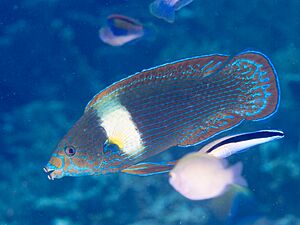Tubelip wrasse facts for kids
Quick facts for kids Tubelip wrasse |
|
|---|---|
 |
|
| female | |
 |
|
| male | |
| Conservation status | |
| Scientific classification | |
| Synonyms | |
|
Genus:
Species:
|
The tubelip wrasse (Labrichthys unilineatus) is a cool fish found in the warm waters of the Indian Ocean and the western Pacific Ocean. This fish loves to live in calm lagoons and on colorful coral reefs. You can find them swimming in shallow areas, from the surface down to about 20 meters (65 feet) deep. The tubelip wrasse can grow up to 17.5 centimeters (about 7 inches) long. People sometimes catch them for local fishing, and they are also seen in aquariums. This fish is the only known member of its special group, called a genus.
Contents
What Does the Tubelip Wrasse Look Like?
Young tubelip wrasses are brown with two bluish-white stripes along their bodies. As they get bigger, these stripes slowly fade away. Female tubelip wrasses are usually yellowish-brown with faint stripes.
Male and Female Differences
Male tubelip wrasses are much brighter and more colorful than the females. They often have a big yellow patch near their pectoral fins, which are the fins on their sides.
Their Special Lips
One of the most interesting things about this fish is its thick, fleshy yellow lips. When the fish closes its mouth, these lips form a short tube, which is how it got its name! The top of its head is covered in scales, except for a small area over its upper lip, in front of its eyes, and on its chin.
Fins and Size
The tubelip wrasse has a dorsal fin (on its back) with 9 strong spines and 11 or 12 soft rays. Its anal fin (on its belly) has 3 spines and 10 or 11 soft rays. The biggest males can reach a total length of about 17.5 centimeters (7 inches).
Where Does the Tubelip Wrasse Live?
The tubelip wrasse lives across a very wide area, from the coast of East Africa (like Tanzania and Mozambique) all the way through the Indian Ocean. It also lives in the Pacific Ocean, reaching places like Micronesia and Samoa. You can find them as far north as the Ryukyus islands and Taiwan, and south to Australia's famous Great Barrier Reef and Lord Howe Island.
Home and Food
The tubelip wrasse prefers shallow reefs in lagoons and reefs that are somewhat protected from strong waves. They love places with lots of coral, especially branching corals like staghorn corals (from the Acropora group). These corals are super important because the tiny soft parts, called polyps, are the main food for the tubelip wrasse.
How Humans Use This Fish
The tubelip wrasse is not a major target for big fishing companies. However, it is sometimes caught by local fishers. You might also see this colorful fish in the aquarium trade, where people keep them as pets in their home tanks.



